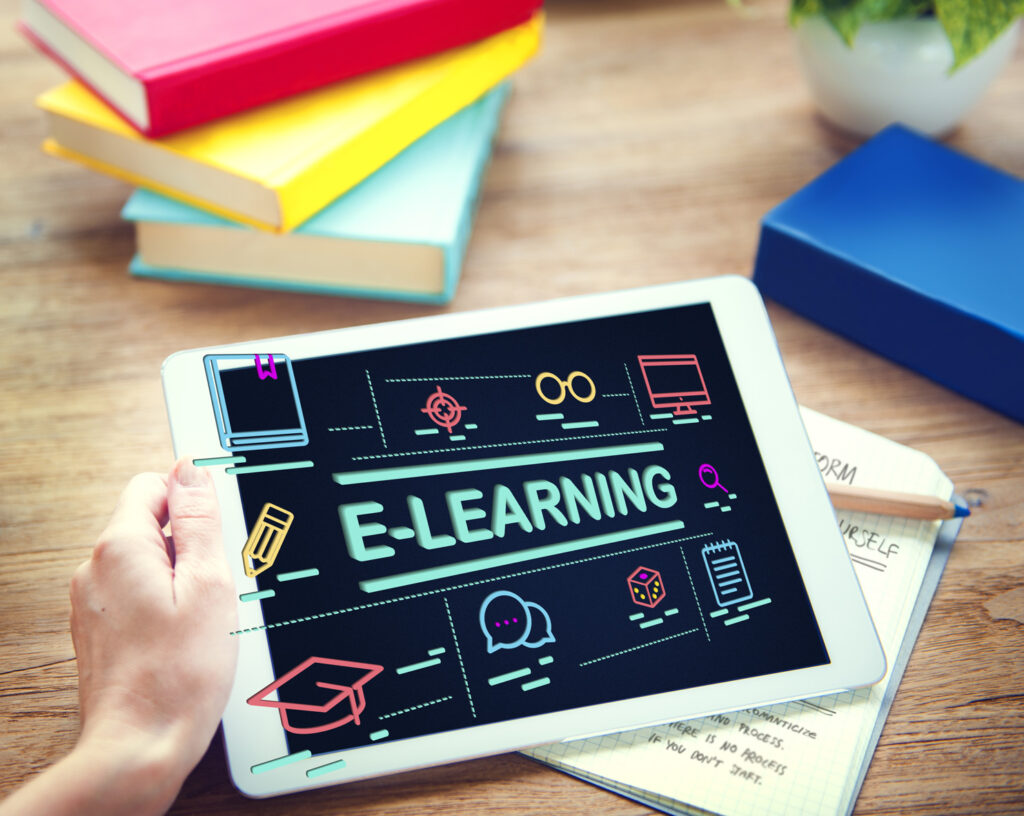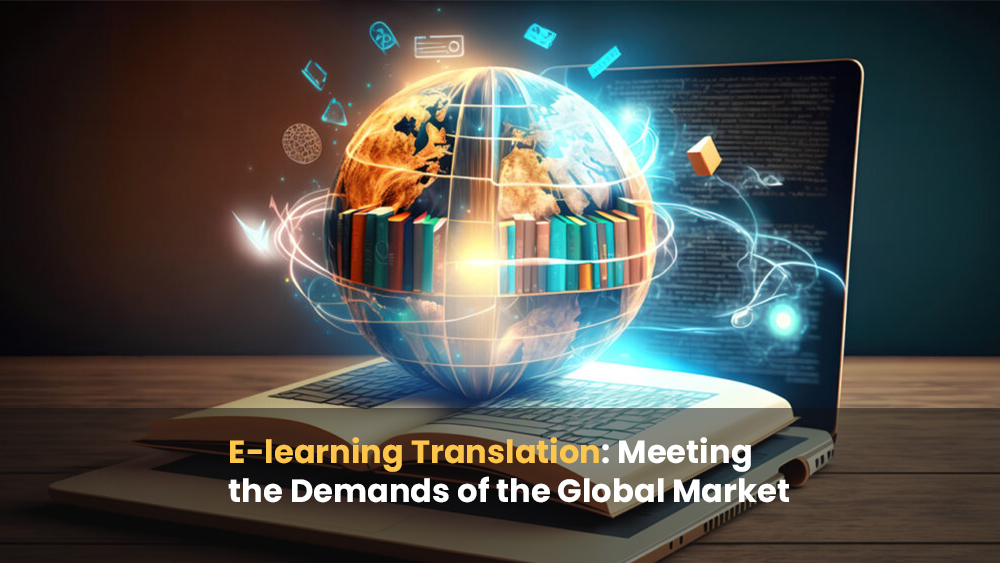Online education has become increasingly popular, and e-learning platforms have become a primary source of learning for people worldwide. However, with the rising demand for online education, there is a growing need for e-learning translation services.
E-learning translation involves the process of translating e-learning content, including courses, modules, quizzes, and other educational resources, from one language to another. E-learning translation is essential in meeting the global market’s needs and is an important factor in the success of e-learning platforms.
This article will explore the importance of e-learning translation, the types of e-learning content that need to be translated, and the best practices for translating e-learning content. We will also discuss the difference between translation and localisation, the role of subject matter experts in e-learning translation, and the challenges that need to be addressed in e-learning translation.
Table of Contents
Translation Demand on E-learning Platforms

Growth of the e-learning market
The e-learning market has experienced significant growth due to the increasing demand for flexible and accessible education, technological advancements, and the COVID-19 pandemic. The global e-learning market was valued at $144 billion in 2019, and it is expected to grow at a compound annual growth rate of 8.44% from 2020 to 2025. E-learning platforms provide learners with the opportunity to access educational resources from anywhere in the world at any time, making education more accessible.
Advancements in technology, such as high-speed internet and mobile devices, have made it easier to create and deliver e-learning content. As the e-learning market continues to grow, the demand for e-learning translation services will also increase, highlighting the importance of e-learning translation in meeting the needs of the global market.
What is the importance of translation in the e-learning industry?
Translation is crucial in the e-learning industry. It enables learners worldwide to access educational resources in their native language, breaking down language barriers and ensuring the content is culturally relevant and appropriate for the target audience. E-learning translation also helps to increase the industry’s efficiency and cost-effectiveness, attracting more clients and customers. Therefore, translation plays an essential role in enabling learners worldwide to access educational resources and providing cost-effective, accessible education.
Is there an increased demand for translation services in e-learning?
As of 2024, there is still an increased demand for translation services in e-learning due to the growth of the e-learning industry. As more people turn to online education, there is a growing need for e-learning content to be translated into multiple languages to reach a global audience.
The demand for e-learning translation services is expected to increase in the coming years, driven by factors such as the rising demand for personalised learning and the need for cost-effective training solutions. Additionally, the COVID-19 pandemic has accelerated the growth of the e-learning market, further increasing the demand for e-learning translation services as more people turn to online education during lockdowns and social distancing measures. Therefore, there is a significant demand for translation services in the e-learning industry, and this trend is expected to continue in the future.
E-learning Content: How to Translate E-learning Content

What are the types of e-learning content?
The types of e-learning content can vary widely, depending on the specific needs and objectives of the course or training program. Some common types of e-learning content include:
- Online courses: Complete courses that cover a specific topic or subject area and are delivered entirely online.
- Modules: Smaller, self-contained units of learning that are often used to supplement a larger course or program.
- Videos: Audiovisual content that can be used to deliver lectures, demonstrations, or other forms of instruction.
- Quizzes and assessments: Interactive tools that allow learners to test their knowledge and understanding of the material.
- Games and simulations: Interactive experiences that allow learners to practice and apply skills in a safe, controlled environment.
- Webinars: Live or recorded online events that allow learners to participate in a presentation or discussion.
- Social learning: Collaborative learning experiences that leverage social media and other technologies to facilitate communication and interaction among learners.
- Mobile learning: E-learning content that is designed to be accessed and consumed on mobile devices, such as smartphones and tablets.
These are just a few examples of the types of e-learning content that may be used in a course or training program. The specific types of content used will depend on various factors, such as the learning objectives, the target audience, and the available resources.
What are the best practices for translating e-learning content?
Translating e-learning content requires specialised skills and knowledge to ensure that the translated content is accurate, culturally relevant, and appropriate for the target audience. Here are some best practices for translating e-learning content:
- Use professional translators: E-learning translation should always be done by professional translators with expertise in the specific subject matter and target language. They should have experience in e-learning translation and knowledge of specialised e-learning terminology.
- Use translation memory tools: Translation memory tools help maintain consistency and accuracy across different courses and modules. These tools store previously translated content to be reused in future projects, ensuring consistency and reducing the turnaround time for translation projects.
- Use glossaries: Glossaries help ensure consistency and accuracy in translations by providing a list of key terms and phrases with their translations. Glossaries should be created in collaboration with subject matter experts and should be reviewed and updated regularly.
- Use culturally appropriate language: E-learning content should be translated to reflect the cultural norms and values of the target audience. Translators should be familiar with the target culture and understand how to adapt the content to be culturally appropriate.
- Consider visual elements: E-learning content often includes visual elements such as images, graphics, and videos. Translators should consider how these elements may need to be adapted for the target audience, including any potential cultural differences.
- Proofread and edit: Translated content should be proofread and edited to ensure accuracy and consistency. This may include reviewing the content for grammar, spelling, and punctuation errors, as well as ensuring that the translation is faithful to the original content and culturally appropriate.
By following these best practices, translators can ensure that e-learning content is accurately translated, culturally relevant, and appropriate for the target audience.
E-learning Translation and Localisation

What is the difference between translation and localisation in eLearning?
Translation refers to the process of converting the text from one language to another. In eLearning, this includes translating the text of the course, including subtitles, audio scripts, and other written content. Translation is a necessary step when creating content that will be used by learners who speak different languages.
Localisation, on the other hand, refers to the process of adapting the content to the specific cultural and linguistic nuances of the target audience. This process goes beyond mere translation and involves adapting images, audio, and other multimedia components to reflect the target audience’s culture, customs, and preferences.
What is cultural adaptation in e-learning localisation?
Cultural adaptation is an important aspect of e-learning localisation. It involves a deep understanding of the target audience’s cultural context. This includes an understanding of their beliefs, values, and attitudes towards learning. Adaptation may include changing examples, case studies, or even the course’s content to make it more relevant and engaging.
For example, a course created for a Western audience may include examples and case studies that reflect Western cultural values and beliefs. However, these same examples and case studies may not be relevant or engaging for learners in other cultures. In such cases, the content may need to be adapted to reflect the cultural context of the target audience.
Cultural adaptation is an essential aspect of e-learning localisation, as it helps to ensure that the content is not only translated into the target language but is also culturally appropriate and relevant.
Collaboration With Subject Matter Experts
What is the role of subject matter experts in e-learning translation?
Subject matter experts (SMEs) play a crucial role in e-learning translation. They are responsible for ensuring that the content is translated accurately and effectively while maintaining its technical accuracy and relevance.
SMEs are experts in their field and have a deep understanding of the subject matter. They are responsible for reviewing the translated content to ensure that it accurately reflects the original text and is free from errors, omissions, or inaccuracies. They may also be involved in the translation process itself, guiding technical terminology, jargon, and industry-specific language.
How to effectively collaborate with subject matter experts?
Collaborating effectively with SMEs is a crucial aspect of e-learning content development. By involving SMEs early in the process, one can ensure that the content is accurate and relevant from the outset. This also helps to build a positive working relationship with the SMEs, which can be beneficial throughout the development process. Defining the learning objectives of the course with SMEs is also important, as this will help to ensure that the content is focused and relevant to the learners’ needs.
Leveraging technology is also vital for effective collaboration with SMEs. For example, video conferencing, shared document collaboration, and project management tools can help to facilitate communication and collaboration. Providing context about the learners should not be undermined, as this can help SMEs to provide content that is relevant and engaging for the target audience.
Finally, showing appreciation for the SMEs’ contributions throughout the development process can help build a positive working relationship and ensure that the SMEs are motivated to continue contributing to the project.
What are the benefits of working with subject matter experts in e-learning translation?
Working with SMEs in e-learning translation is an excellent way to ensure that the content is technically accurate and relevant to the learners. They can help streamline the translation process, leading to significant time and resource savings.
In addition, working with SMEs can also improve the quality of the content, making it more effective in achieving the desired learning outcomes. SMEs bring credibility to the content, helping to establish it as a trustworthy source of information for the learners. All of these factors make working with SMEs in e-learning translation a valuable investment for any organisation looking to create effective and engaging e-learning content.
Conclusion
E-learning translation is becoming increasingly important as the world becomes more interconnected and globalised. With the rise of online learning platforms and remote work, the demand for e-learning translation services is growing rapidly. Accurate and efficient e-learning translation can help bridge language barriers, improve communication, and expand access to education and training programs around the world.
In the future, e-learning translation is expected to play an even more significant role in the global market. As more businesses and organisations adopt remote work and online learning, the need for high-quality e-learning translation services will only continue to increase. With the help of advanced technologies such as AI-powered translation tools, e-learning translation will become more efficient and cost-effective while maintaining or even improving accuracy. The future of e-learning translation is bright, and it is poised to contribute to the growth and development of the global economy.
Read more
- The Pandemic’s Impact on Translation Industry
- Navigating Cultural Resonance Through Transcreation
- Successful Strategies for Localizing Mobile Apps
- Navigating Cultural Resonance Through Transcreation
- Audio and Video Translation
- Translators and Interpreters: Bridging the Language Gap
- Effective Translations and Localization for Middle Eastern Countries
- Navigating Business and Language Diversity in Iraq
- Celebrating World Arabic Language Day
- Maximizing Language Services for Success: Essential Strategies
- Should You Translate Your Brand Name?
- Can You Learn English with AI?
E-Learning Translation Challenges
What are some technical, linguistic and cultural challenges in e-learning translation?
From a technical perspective, challenges include the use of specialized software tools like Learning Management Systems (LMS), authoring tools, and various multimedia software. Linguistically, it involves accurately translating technical terminology and maintaining consistent language use. Culturally, it requires deep understanding of the target culture to ensure culturally appropriate translations.
What are some linguistic challenges in e-learning translation?
Linguistic challenges involve translating technical terminology accurately, maintaining terminology consistency, and adapting content to suit the target audience’s language, tone, and formality. This requires linguistic expertise, cultural understanding, and specialized tools for managing terminology and ensuring consistency.
What are some cultural challenges in e-learning translation?
Cultural challenges in e-learning translation include understanding the target culture’s language, social norms, and cultural references to ensure translated content is culturally relevant and appropriate. Collaboration with subject matter experts and cultural consultants is often necessary to adapt content appropriately.
